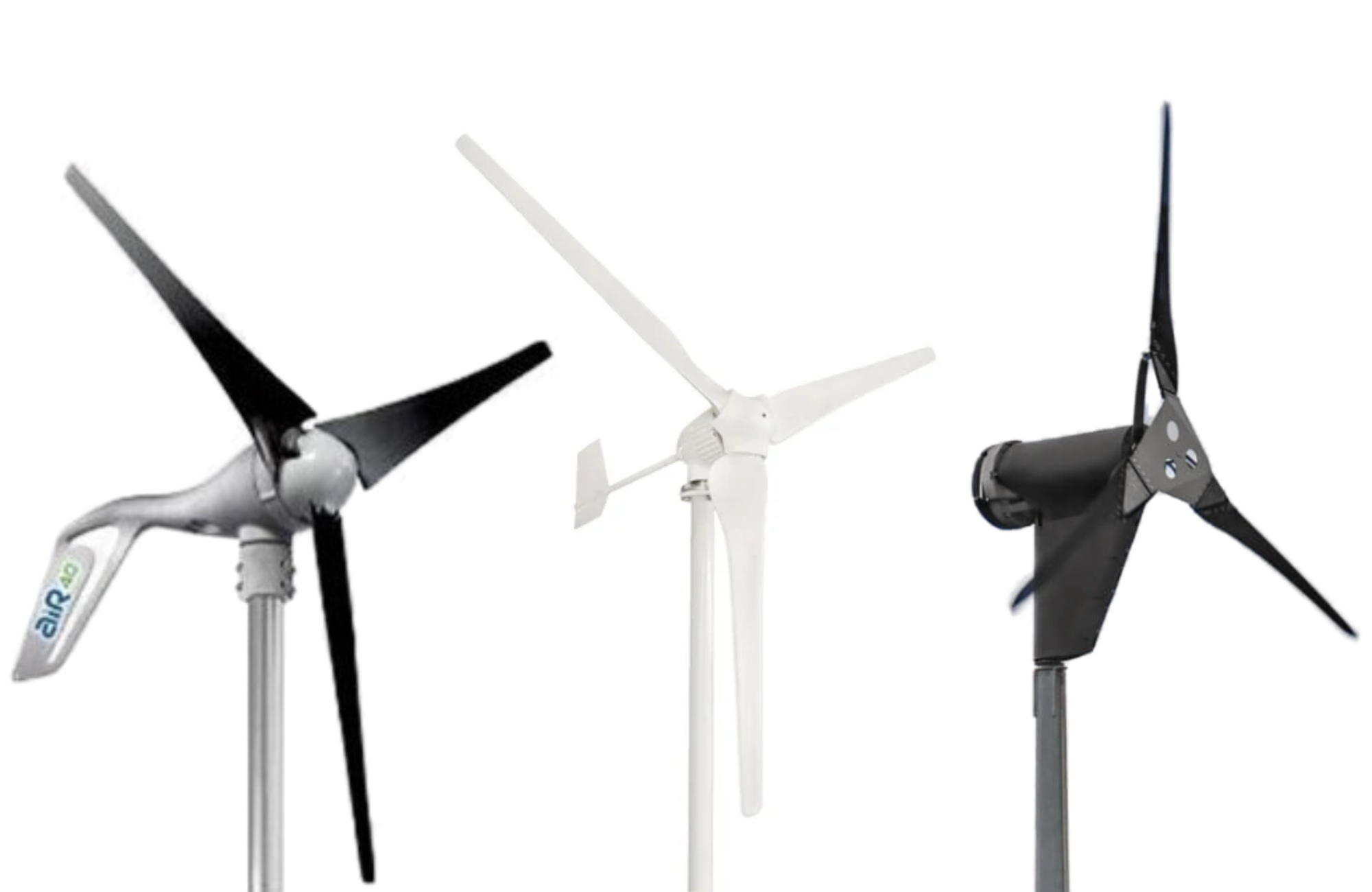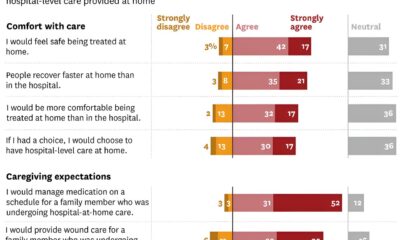Technology
The best home wind turbines in 2024, according to experts

We may earn revenue from the products available on this page and participate in affiliate programs. Learn more ›
With more and more people becoming energy-conscious and wanting to save the planet from global climate change, there’s an increased interest in home wind turbines. “Harness the wind!” It feels good to say, and if you already have one of our favorite generators for homes, it’s a perfect way to fill it up with power. If you’ve been thinking about sustainable energy to handle a portion of your power needs, one of our recommendations for the best home wind turbines—like our best overall pick, the Primus Windpower Air 40—might be just what you need.
How we selected the best home wind turbines
These residential wind turbines were selected for their consistent designs, variable sizes, and (when possible) third-party testing approval. We also chatted with wind expert and general wind turbine critic Paul Gipe for an overview of what not to pick when getting a home wind turbine.
One thing to note is that you’ll need quite a bit of wind to get ample electricity from a wind turbine. A small breeze here and there likely isn’t going to cut it. Check out our solar power home guide instead if that is your issue.)
The best home wind turbines: Reviews & Choice
The following wind turbines represent solid designs, good build quality, and a satisfied customer base. While the essential design of the turbine itself will look similar throughout, there are a variety of sizes and prices available for you to choose from here.
Best overall: Primus Windpower Air 40
Why it made the cut: This certified, affordable, small home wind turbine should suit your needs well.
Specs
- Swept area: 1.07 square meters
- Height: Adjustable as needed
- Certification: IEC
Pros
- Certified yet affordable
- Survives up to 90 mph winds
- Not giant
Cons
The Primus Windpower Air 40 is an IEC-certified home wind turbine for residential areas that are looking for hybrid power solutions. For example, it can help with lighting, water pumping, and more. It is not one of the giant wind turbines that you’ve seen, which can be good if you just want more power but not full power from wind. One suggested application is to combine it with solar paneling as a sort of hedge bet (the kind you install on your roof or in your backyard, as opposed to the portable kind—though those have good uses, too). When the wind is low, and the sun is strong, let the solar paneling take over; when it is overcast, let the Primus take the wheel.
As a result of the Primus Windpower Air 40’s lack of extreme size (it is only about a yard in diameter) and mounting to tubing or pipes of 1.9 inches in diameter, it can go just about anywhere. It will also survive winds up to 90 mph, so it should still prevail if you do have the occasional extreme gust.
While the Prime Windpower Air 40 remains the best home wind turbine for most people and a non-scary, affordable entry point, you may want bigger if you want more power. That’s just how it works for wind energy. However, with realistic expectations of what you can get out of your local wind and an offset, not replacement, mentality, you should like this wind turbine.
Best splurge: SD Wind Energy SD6
Why it made the cut: This is the premium choice for long-term wind energy collection.
Specs
- Swept area: ~24.6 square meters
- Height: 9 / 15 / 20 meter options
- Certification: SWCC
Pros
- Prestigious SWCC certification
- Good for rural domestic homes
- Should qualify for 30 percent price reduction
- Rated for 5.2kW @ 11m/s of wind
Cons
- Very expensive
- Largeness can be bad, too
Depending on who you are, the SD6 is either going to be an incredibly easy or incredibly hard sell. It’s the Rolls-Royce of home wind turbines, so to speak, and in no small part due to its price tag of approximately $50,000, depending on the supplier. However, that can be reduced by as much as 30 percent if you qualify for the Small Wind Turbines (Residential) Tax Credit. This is the crux and decision point on the SD6 for most people.
But once you get over the sticker shock, you are left with one of the most reliable wind turbines on the market. It’s certified by the Small Wind Certification Council (SWCC), a group that—at the time of this writing—only has about a half dozen products among its ranks. While we didn’t ask for explicit recommendations from Paul Gipe, the SWCC was his go-to when it comes to certification boards. A SWCC certification is a big deal, and this should be considered one of the overall best home wind turbines out there.
The SD6 is an absolutely giant home wind turbine at 5.6 meters in diameter around the rotor. It will dwarf your home. That’s a good thing, though, as it is recognized that you’ll get the best value out of a bigger wind turbine. It is rated to 5.2kW of power at a wind speed of 11m/s, and its spec sheet shows that it can produce approximately 20,000 kWh of energy at just over 7m/s of average wind speed over the course of a year.
Best eco-friendly: Tumo-Int 1000W 3 Blades 48V Wind Turbine
Why it made the cut: This affordable turbine can survive most climates.
Specs
- Swept area: ~2.5 square meters
- Height: Adjustable as needed
- Certification: N/A
Pros
- Survives most environments
- Potentially long lifespan
- Automatic direction adjustment
Cons
- Not third-party certified
This wind turbine from Tumo-Int is made to last. According to Tumo-Int, it puts out about 640w of power with wind speeds around 20mph. It uses features like automatic direction adjustment to get more out of the wind available to you.
According to the manufacturer, this turbine should last you for 15 years without any maintenance if used correctly. To that end, they offer a 3-year warranty, so you can expect at the very least that much. The turbine’s shell is treated with a primer and enamel that helps prevent common problems for outdoor objects like mold. It will also keep away issues from salt (for example, if you live near the ocean) and tough UV rays. The turbine can spin in temperatures of -40 to 176 degrees Fahrenheit and withstand wind speeds up to 89.5mp/h.
Also worth considering: Automaxx Windmill 1500W Wind Turbine
Why it made the cut: The Automaxx Windmill 1500W Wind Turbine offers high output if you’ve got the space for it.
Specs
- Form factor: Standalone
- Rated Power: 1500W max output
- Start-up wind speed: 5.6 mph
- Rated wind speed: 31 mph
- Safe wind speed: 110 mph
Pros
- Strong output
- Reliable design
- Bluetooth controllable
- Automatic and manual braking system
Cons
- Expensive
- Limited customer support
If you’re looking for a freestanding wind turbine for your backyard that you can order online, the Automaxx Windmill 1500W is a powerful—if expensive—option. It offers a hearty 1,500 watts of continuous output and operates at a relatively wide range of wind speeds. It also features maximum power point tracking (MPPT) that avoids voltage surges due to strong wind gusts and boasts both automatic and manual braking. The MPPT Controller can be monitored and controlled via Bluetooth. It’s certainly not cheap, but it’s a choice if you’re willing to invest and take a chance on an Amazon option.
What to avoid when buying home wind turbines
When we sat down with Paul Gipe—wind expert with over 40 years of experience in the industry and creator of Wind Works—it became clear that there was more to learn to avoid than to seek out. Getting good wind energy is as much a game of avoiding bad energy as getting something good.
It all boils down to spotting odd claims and weird designs.
“It doesn’t kill birds”
Before we get too much in the weeds in this one, it is important to know that wind turbines don’t kill many birds but do kill some birds. Cats, oil, collisions with other objects, and a whole host of other bird killers are above wind turbines in fatalities. But they aren’t completely “innocent” either.
Paul Gipe asserts that real wind turbines do have the capacity to kill birds. Again, this isn’t to say that they are a leading cause of bird death (far from it) but any claims that a model won’t ever kill a bird is misleading and a sign that a manufacturer is willing to bend the truth.
“It’s silent”
Sometimes, a manufacturer will claim that a wind turbine is absolutely silent. While some might be quiet, the friction and moving parts will make noise. That’s just physics.
“It’s got a cool, new design”
In nearly every case, the best home wind turbines are going to have a very similar design. That is, a Mercedes logo-like design of three blades around a spinning area, or some highly similar variation up to five. No need for an excess number of blades. No fancy additions or cups. Though you may see cups atop some home weather stations, those are for measuring the wind, not harnessing it.
Through the years, there have been a number of designs for wind turbines. Only wind turbines that have been through appropriate tests in real-world environments—Paul isn’t a fan of wind tunnel tests for end-user certification, either, just real-life wind—should be used, according to Paul. That goes for wind turbines with the regular three-blade design, too, but especially if you see a unique design. This is an old field and a hard problem to solve. Many unique ideas have been tried and retried to death. Few work.
Unfortunately, a lot of wind turbines with new and unique features are being propped up as the real deal all the time. Paul recommended checking the list of SWCC-approved small wind turbines. Looking for wind turbines with independent testing will help you best.
What to consider before buying home wind turbines
If that’s what to avoid, what should you actually be getting? And what do you need to think about before getting one of the best home wind turbines?
Swept area and power conversion
Let’s take a brief moment to consider the wind turbine power output formula:
Power Output of a Turbine = ½ * Air Density * Wind Speed^3 * Rotor Swept Area * Power Coefficient
Now, unless you have godlike powers, you aren’t going to be able to do anything about air density or speed. As a result, you’re going to need to maximize the exposure that your wind turbine’s blades have with whatever wind you’re getting. (Please note that we don’t advise getting a wind turbine in just any region. You’ll need consistently high winds, not just the occasional breeze, to make them a worthwhile investment.)
The rotor swept area is the area of the circle the blades make when they make a revolution around the turbine’s rotor shaft. It is not just the area of the blades themselves. While bigger blades are heavier, as it so turns out, bigger blades are better in nearly every conceivable case … should you have the space.
A seemingly more mysterious component of your home wind turbine’s power output is its power coefficient. Controlled by more subtle factors and engineering choices, the power coefficient determines how much of the captured wind’s power gets converted into usable power.
Should you expect a power coefficient of 1? No, far from it. Conjectured over 100 years ago, the Betz Limit theorizes that the maximum energy we can capture from wind via turbines is 59.3 percent. Should you expect your home wind turbine to capture that much power? Again, no. Somewhere between 35 percent and 45 percent is considered quite good.
The bottom line: Bigger turbine blades mean more energy.
How much energy do you want, and how much energy do you want to spend shopping
At this point, it becomes apparent that different wind turbines have different power output levels. It should also be somewhat obvious that different wind turbines are more expensive than others.
If you want a wind turbine to connect to your house and power most of it, or even start to get some extra energy to store in one of the best electric generators, you should expect to pay a lot. As we’ve seen above, you’ll also need quite a bit of space for the blades to turn. And that’s not even mentioning a good wind supply.
But that doesn’t have to be the only use case for having a home wind turbine. We’ve discussed “energy bill efficiency renewables” before (i.e., ways to lower your energy bill), and a smaller wind turbine can contribute. In the same way that solar garden lights take on a bit of your home and garden energy needs, a small home wind turbine can do the same.
If you want low-effort shopping and are OK with lower output, there are small wind turbines for home on Amazon—like the Auecoor 800W 12V 24V Solar Panel Wind Turbine Kit and the ultra-budget Pikasola Wind Turbine Generator Kit—that can help you take some load off the grid without spending in the thousands. But they’re not our top picks if you’re serious about top efficiency and reliability. (They might work, however, for boat owners who want to install smaller marine turbines to help power devices and equipment and ensure your batteries stay topped off.)
Robust winds and a good stash of money are prerequisites for it being worth your while to buy one of the best home wind turbines in the most expensive categories, but remember, quality wind turbines will eventually pay for themselves. However, if you accept that you’ll still need consistent grid access and just want something to offset the increased number of smart home devices that come into your home each year, something else can be suitable.
Certifications
Third-party certifications are the hot topic when it comes to small wind turbines. The certification process is often difficult, and it is expensive to get your product tested. Testing takes time to see how the turbine will fare in multiple conditions, installation of the turbine at testing sites, and more.
And the result? Certified wind turbines are reliable yet also frequently very expensive.
At the end of the day, getting a wind turbine certified by a third party would always be the best policy. However, to limit yourself to third-party certified small wind turbines is to limit yourself quite greatly.
To take an analogy from electronics, you might be familiar with products with an IP, or ‘Ingress Protection,’ rating for water resistance. One of the best Android phones, the Samsung Galaxy S23 Ultra, has an IP68 rating. This means that Samsung paid for independent testing, and the phone was found to have an extraordinarily high tolerance for environmental dust and freshwater based on standardized tests. Other products may say they are “water resistant,” but does that mean they are lying? No, not necessarily. It simply means they did not pay for the testing. Sufficiently popular products that claim water resistance and have no large base of dissatisfied customers will inevitably pass the “smell test” for water resistance anyhow.
In the world of small wind turbines, it is considerably more common to skip paying for the test than in the world of handheld electronics.
Location
Wind turbines can produce a fair amount of green electricity for you, but they must be placed well. That means you must take a good, hard look at your property and determine whether wind power makes sense.
With freestanding turbines, you typically want a large open space like a field, large yard, or hilltop position. For a rooftop turbine, you need to find a spot on your roof that won’t be obstructed by trees where you can secure the turbine safely. Ensure your roof can handle the weight, and it probably shouldn’t be at a sharp incline.
If you don’t want a wide open space or safe spot on your roof that isn’t obstructed, you won’t be able to get the maximum output of turbine wind power for home. In that case, you may want to look at other ways of generating sustainable energy.
FAQs
A home wind turbine can cost anywhere from around $50,000 to as low as around $1,000. There’s really a huge range in what’s available. Larger ones that cost more will recoup costs in the long run, though the initial payment can be hard to stomach.
Home wind turbine systems are typically easy to install if you’re the one who needs to do it. Some “small” home wind turbine systems are actually quite large and require more intense installation, but there is a much higher likelihood that the turbine provider will do or help with the installation.
Depending on your local laws, you may need planning permission for wind turbines. According to government energy resource WindExchange, laws vary dramatically across the country. This is also an area of high fluctuation and consistently changing laws. For example, a July 1, 2024, law prohibits wind turbines within one mile of the Florida coastline.
The average American household uses between 8,000 and 10,000 kWh per year, so to match that you need roughly 800 kWh per month, or just shy of 30 kWh per day. The average 1,000 W wind turbine is capable of generating approximately 3 kWh per day, so you’re either going to need nearly a dozen turbines to generate that much energy and only if you have enough open space to place them well. Given that, most people simply cannot power a house using wind power alone.
Most residential wind turbine owners with one or two turbines use them to cut down on energy costs and/or to provide emergency backup power in an emergency.
Final thoughts on the best home wind turbines
Getting the best home wind turbine for your home is no small feat—sometimes quite literally. It takes a big product to get the level of energy you will likely want in an efficient manner. Still, though, you can get some residential wind energy at any level. The preceding wind power generators for home will help you start your journey to sustainable energy production and reducing energy bills, whether you want to keep your smart refrigerator running or your electric commuter bike rolling.
Why trust us
Popular Science started writing about technology more than 150 years ago. There was no such thing as “gadget writing” when we published our first issue in 1872, but if there was, our mission to demystify the world of innovation for everyday readers means we would have been all over it. Here in the present, PopSci is fully committed to helping readers navigate the increasingly intimidating array of devices on the market right now.
Our writers and editors have combined decades of experience covering and reviewing consumer electronics. We each have our own obsessive specialties—from high-end audio to video games to cameras and beyond—but when we’re reviewing devices outside of our immediate wheelhouses, we do our best to seek out trustworthy voices and opinions to help guide people to the very best recommendations. We know we don’t know everything, but we’re excited to live through the analysis paralysis that internet shopping can spur so readers don’t have to.













